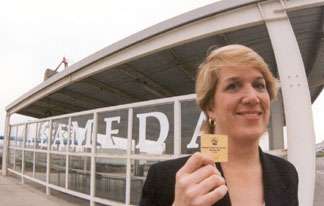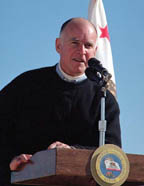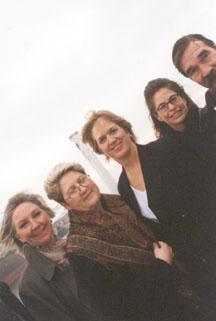Newly-elected Mayor Bev Johnson brings her dynamic leadership not just to the bustling "Isle of Style" of Alameda but also to the Water Transit Authority as its newest member. She adds her enthusiasm to that of thousands of Alamedans who are already hooked on water transit as the wave of the future.

Published: February, 2003
Mayor Beverly Johnson practices law in her hometown, Alameda. In 1995, then-Mayor Ralph Appezzato appointed her to the Alameda Planning Board; she was elected to serve on the City Council four years later and was elected Mayor this past November. Mayor Johnson recently took time out of her busy schedule to talk with Bay Crossings about her championship of the Water Transit Authority’s plan to expand Alameda’s ferry system. An excerpt of her interview follows.
Q: Mayor Johnson, many of our readers may not be familiar with Alameda. Could you give a quick description of Alameda for their benefit?
BJ: Alameda is an island in San Francisco Bay. Three bridges and a tube on the east side of the island connect to Oakland. The Bay Farm Bridge connects Bay Farm Island, which is also part of Alameda, and Oakland, in the area of the Oakland Airport. Coast Guard Island is also part of Alameda. The population is about 74,000. We’re in the process of working with the federal government to gain title to the closed Alameda Naval Air Station, and hopefully we’ll get title and we’ll be able to redevelop that base, which is about a third of our island.
Q: Being that Alameda is an island, is this why ferries have played such an important and colorful role in its history?
BJ: Oh, absolutely. I’m so glad that we got the ferry started again. Throughout Alameda’s history, ferries have been an important mode of transportation. When my grandmother was a teacher in San Francisco, she took the trolley through Alameda and then the ferry to San Francisco. This was before the San Francisco bridge was built. It’s such an addition to our transportation because getting on and off the island is one of the issues that we have because of our limited ingress and egress.
Q: The Alameda ferry played a mighty important role in the earthquake. Do you think about that in terms of 9/11 and disaster scenarios and emergency preparedness?
BJ: Yes, because in the event of an emergency, if bridges or a tunnel were destroyed and we had to get people off the island, we would really rely on ferries.
Q: Your predecessor, Mayor Ralph Appezzato, was a founding member of the San Francisco Bay Area Water Transit Authority, the new state authority created to study, plan, develop, and operate a regional, comprehensive regional ferry system. Will you be continuing Ralph’s work?
BJ: Yes, I will. The City Council has approved my nomination to serve on the WTA’s Community Advisory Committee and I hope to succeed Mayor Appezzato on the WTA’s Board of Directors.
Q: That’s good news. One of the plans that WTA is studying is the possibility of a ferry that would go from Harbor Bay to the South Bay, opening up a connection between the East Bay and the South Bay. What do you think of that notion?
BJ: I like the idea. I think that we can’t just keep widening freeways and adding more cars – and even buses; they have to drive on the freeway, too. I think we need to take advantage of all forms of transportation. We are so fortunate in the Bay Area to have the opportunity to have ferries. So, the more places we can serve people with ferries, the better.
Q: Alameda is served by buses from AC Transit, which is part of our regional network. Yet its ferry system is supported directly by Alameda, along with the Port of Oakland. Doesn’t it make more sense for the ferry system to eventually be part of a regional network that is supported regionally, since it benefits the region?
BJ: It’s my understanding that that’s one of the issues the Water Transit Authority is looking at as a regional system for the ferries. And I think it would be good to coordinate it regionally, just like I believe the other forms of transit should be coordinated regionally. Then, we can serve people most efficiently and make it more convenient so that more people are likely to take it. One of the things we’ve been trying to do in Alameda is integrate the different forms of transportation and transit so that they work together more seamlessly.
Q: You mentioned earlier how redevelopment plans are a pretty big deal in Alameda with the Naval Air Base. Do ferries stand to figure in those plans?
BJ: Yes, it’s something that we’re definitely looking at and trying to make our ferry service even better.
Q: Alameda seems to be gentrifying pretty quickly. Is that creating problems?
BJ: Well, housing of all kinds, especially affordable housing, is an issue in the Bay Area, not just Alameda. I know that many people have moved over from San Francisco because housing in Alameda is more affordable than it is in San Francisco. But it’s still unaffordable for many people. And so, yes, the City has required that 25 percent of the new housing developments, including housing at the airbase redevelopment, be affordable. It’s earmarked for different income categories.
Q: State Senator Don Perata is the ferry champion. He led the effort to create the WTA and the concept of a comprehensive regional ferry system. Right now he is involved in the all-important work of examining the possibility of raising bridge tolls. The Golden Gate Bridge, as you know, has raised its toll to $5, and the rest of the state bridges are still at $2, which seems incongruous. The plan is to increase them to at least $3 and dedicate a portion of that increase to a comprehensive regional ferry plan. Will you support that plan?
BJ: Yes, I will, because money is very limited. Drivers sometimes raise the issue of subsidizing ferries. I think they forget that even driving your car is a subsidized form of transportation because somebody has to pay for the roads and the Highway Patrol and all those things that go along with it. And so it’s expensive too – if you’re going to drive and commute to San Francisco over the bridge. I support the concept of using that opportunity to collect more money to provide more ferry service and other new transit projects throughout the Bay Area. It will get more people out of their cars, hopefully, and off the bridge, so those who do wish to continue driving will have a less hectic trip.
Q: A couple thousand or so Alamedans are choosing to ride the ferry even though it’s less convenient and more expensive. Who are these people? Why do they do this?
BJ: It’s a very nice way to commute to work. If I commuted where I could take a ferry, I would definitely do that. I just think it’s such a pleasant way to go to work. I just think that, once people start riding the ferry, they kind of get hooked. And I’m glad to see that.



